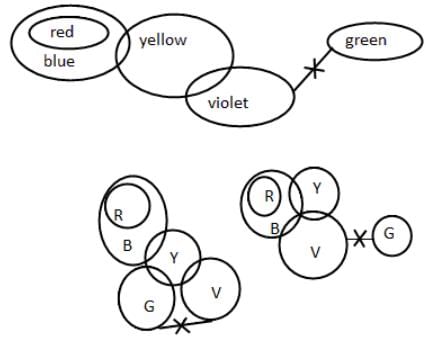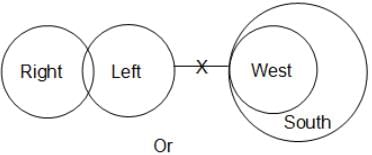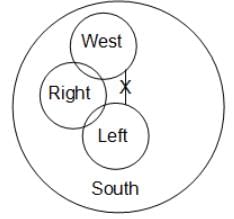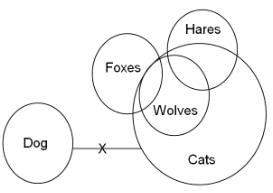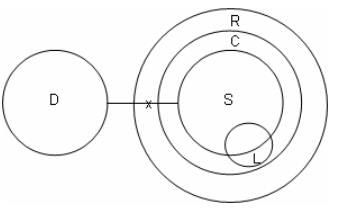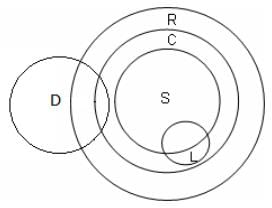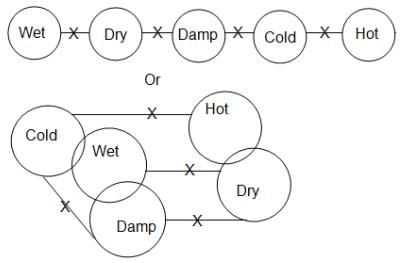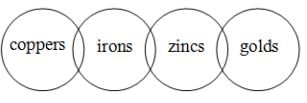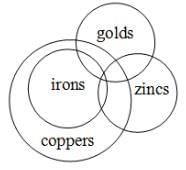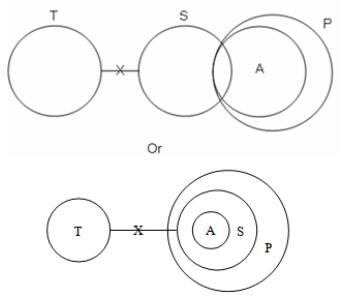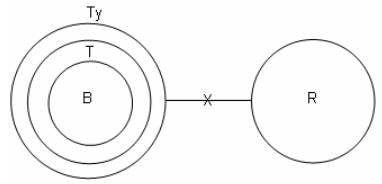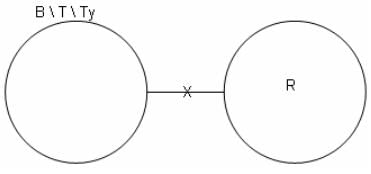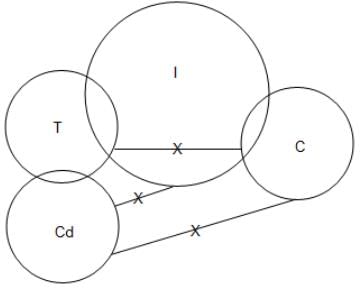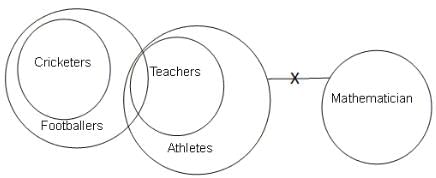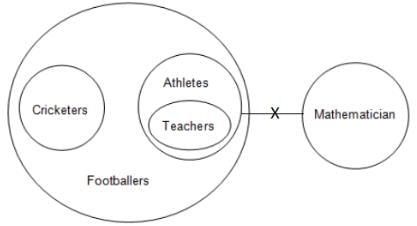Test Level 3: Syllogism - CAT MCQ
10 Questions MCQ Test Level-wise Tests for CAT - Test Level 3: Syllogism
Directions: In this question, four statements are given followed by three conclusions numbered I, II and III. You have to take the given statements to be true even if they seem to be at variance from commonly known facts. Read the statements and then decide which of the given conclusions logically follow(s) from the given statements, disregarding commonly known facts.
Statements:
All red are blue.
Some blue are yellow.
Some yellow are violet.
No violet is green.
Conclusions:
I. Some red are yellow.
II. No yellow is green.
III. Some blue can be violet.
All red are blue.
Some blue are yellow.
Some yellow are violet.
No violet is green.
Conclusions:
I. Some red are yellow.
II. No yellow is green.
III. Some blue can be violet.
Directions: This question consists of three statements followed by four conclusions marked I, II, III and IV. Consider the statements to be true, even if they seem to be at variance from commonly known facts, and decide which of the given conclusions logically follow(s) from the statements, disregarding commonly known facts. Mark your answer accordingly.
Statements:
Some right are left.
No left is west.
All west are south.
Conclusions:
I. No right is west.
II. Some left are west.
III. Some south are not left.
IV. All south are left.
Some right are left.
No left is west.
All west are south.
Conclusions:
I. No right is west.
II. Some left are west.
III. Some south are not left.
IV. All south are left.
Directions: In each of the following questions, four statements followed by three or four conclusions marked I, II, III and IV are given. Consider the statements to be true even though they seem to be at variance with the commonly known facts and find out which of the given conclusions logically follow(s) the statements, disregarding the commonly known facts.
Statements:
Some foxes are wolves.
No cat is dog.
All wolves are cats.
Some wolves are hares.
Conclusions:
I. Some dogs are not wolves.
II. All dogs are wolves.
III. Some foxes being dogs is a possibility.
IV. All hares being dogs is a possibility.
Some foxes are wolves.
No cat is dog.
All wolves are cats.
Some wolves are hares.
Conclusions:
I. Some dogs are not wolves.
II. All dogs are wolves.
III. Some foxes being dogs is a possibility.
IV. All hares being dogs is a possibility.
Directions: In the following item, some statements are given, followed by four conclusions numbered I, II, III and IV. You have to take the given statements to be true, even if they seem to be at variance from commonly known facts. Read all the statements and then decide which of the given conclusions logically follow(s) from the given statements, disregarding commonly known facts.
Statements:
No deposit is a saving.
All savings are current.
All current are recurring.
Some savings are not loans.
Conclusions:
I. Some deposits are current.
II. Some deposits are not current.
III. Some current are not loans.
IV. Some savings are not recurring.
Directions: In each of the following questions, four statements followed by three or four conclusions marked I, II, III and IV are given. Consider the statements to be true even though they seem to be at variance with the commonly known facts and find out which of the given conclusions logically follow(s) the statements, disregarding the commonly known facts.
Statements:
No wet is dry.
No hot is cold.
No cold is damp.
No damp is dry.
Conclusions:
I. No hot is dry.
II. Some cold being wet is a possibility.
III. No damp is wet.
IV. Some hot is dry.
Directions: The question below consists of three statements followed by four conclusions numbered I, II, III and IV. You have to take the given statements to be true even if they seem to be at variance with commonly known facts. Read all the conclusions and then decide which of them logically follow(s) from the given statements disregarding commonly known facts.
Statements:
Some coppers are irons.
Some irons are zincs.
Some zincs are golds.
Conclusions:
I. Some zincs are coppers is a possibility.
II. Some zincs are irons.
III. Some irons are golds is a possibility.
IV. All irons are coppers is a possibility.
Directions: In the following question, three statements are followed by four conclusions numbered I, II, III and IV. You have to take the given statements to be true even if they seem to be at variance from commonly known facts. Read all the conclusions and decide which of the given conclusions logically follow(s) from the given statements, disregarding the commonly known facts.
Statements:
No tree is sky.
Some skies are aeroplanes.
All aeroplanes are pilots.
Conclusions:
I. Some aeroplanes are not sky.
II. Some skies are pilots.
III. Some trees are sky.
IV. Some pilots are not trees.
Directions: The question below consists of three statements followed by four conclusions numbered I, II, III and IV. You have to take the given statements to be true even if they seem to be at variance with commonly known facts. Read all the conclusions and then decide which of them logically follow(s) from the given statements disregarding commonly known facts.
Statements:
All buses are trucks.
All trucks are tyres.
No tyres are railways.
Conclusions:
I. All tyres are buses.
II. No truck is railway.
III. Some tyres are not trucks.
IV. No bus is railway.
Directions: The question below consists of three statements followed by four conclusions numbered I, II, III and IV. You have to take the given statements to be true even if they seem to be at variance with commonly known facts. Read all the conclusions and then decide which of them logically follow(s) from the given statements disregarding commonly known facts.
Statements:
No tea is coffee.
No coffee is cold drink.
No cold drink is ice cream.
Conclusions:
I. No coffee is tea.
II. Some cold drink is tea is a possibility.
III. Some coffee is ice cream is a possibility.
IV. Some tea is ice cream is a possibility.
Directions: The question consists of four statements followed by conclusions. Consider the given statements to be true even if they seem to be at variance from commonly known facts. Read all the conclusions and then decide which of the conclusions does not logically follow from the given statements, using all the statements together. Mark that conclusion as your answer.
Statements:
All cricketers are footballers.
Some footballers are teachers.
All teachers are athletes.
No athlete is a mathematician.
|
5 docs|250 tests
|


